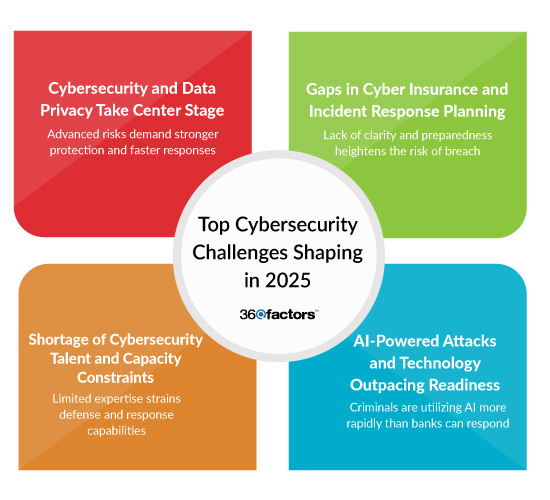Home/ Blog / Cybersecurity for Community Banks in 2025: Top Challenges and Smart Strategies
As 2025 unfolds, cybersecurity for community banks has become a defining concern. Institutions are navigating an increasingly hostile risk environment marked by sophisticated phishing campaigns and persistent ransomware attacks. Simultaneously, the regulatory landscape continues to evolve, imposing greater scrutiny and more complex audit requirements that demand precision, preparedness, and continuous oversight.
For community banks, which often operate with lean resources, the stakes are high. Protecting sensitive customer data while preserving trust is not only a competitive imperative but also a regulatory necessity. Yet, many institutions are grappling with constrained cybersecurity talent, limited access to automation, and siloed risk management practices.
The latest CSI Banking Priorities Report provides a critical lens into the preparedness state of cybersecurity for community banks. It reveals that while 91% of bankers believe they understand their institution’s cyber risk, only 87% feel confident their organization would avoid negligence in the event of a data breach. This gap between perceived awareness and actual accountability highlights a growing urgency: community banks must not only enhance their technical defenses but also refine governance, align leadership priorities, and adopt streamlined, right-sized solutions that support resilience in the face of mounting cyber and compliance challenges.
Key Cyber Challenges Facing Community Banks in 2025

Cybersecurity and Data Privacy Take Center Stage
Cybersecurity and data privacy emerged as the foremost concerns for small business banking in 2025, with 28% of bankers identifying them as the most pressing issue. This heightened focus reflects the growing complexity and frequency of cyber risks, including phishing, ransomware, account takeover attempts, and vulnerabilities in cloud-based infrastructures. As risk actors deploy increasingly advanced tactics, community banks must prioritize proactive visibility across digital assets, accelerate incident response capabilities, and implement tighter internal controls to safeguard sensitive data and maintain regulatory compliance.
Gaps in Cyber Insurance and Incident Response Planning
Despite the recognized importance of cybersecurity for community banks, substantial gaps persist in defensive measures. 14% of bankers expressed uncertainty about the adequacy of their cyber insurance coverage. Meanwhile, 10% acknowledged a lack of readiness to respond effectively to a cyber incident. This lack of clarity and preparedness could leave institutions vulnerable to both financial loss and reputational damage in the event of a breach. Robust incident response planning, including data backups, communication protocols, and recovery strategies, is essential for minimizing exposure and facilitating timely mitigation.
AI-Powered Attacks and Technology Outpacing Readiness
Cybercriminals are integrating artificial intelligence into their attacks, compounding the challenge for financial institutions. AI is now used to automate and scale social engineering tactics, making phishing attacks more targeted and convincing. Many small business banks struggle to keep pace with this rapid technological change. Limited resources and budget constraints often hinder their ability to acquire or deploy emerging tools, creating a widening gap between the evolution of risks and institutional readiness to address them.
Shortage of Cybersecurity Talent and Capacity Constraints
Talent shortages further strain banks’ ability to respond. 13% of bankers cited difficulties in acquiring professionals skilled in cybersecurity for community banks as a major hurdle. As a result, existing teams are often overstretched, relying on automation tools or external vendors to fill critical gaps. This reliance underscores the need for scalable, easy-to-deploy cybersecurity solutions specifically designed for smaller institutions.
Assessing the True State of Cyber Preparedness Among Small Banks
Confidence in Risk Awareness vs. Breach Accountability
While most community bankers express a strong understanding of their institution’s cyber risk profile, the confidence does not fully extend to breach accountability. According to the CSI Banking Priorities Report, 91% of respondents believe they have a clear understanding of their institution’s cybersecurity exposure. Similarly, 85% are confident their organization would not be considered negligent in the event of a breach. While both figures suggest strong confidence in both awareness and accountability. However, the focus for many institutions is now shifting toward reinforcing confidence with clearer documentation, well-defined policies, and safeguards that can withstand regulatory scrutiny when needed.
Gaps in Cyber Education and Reporting Clarity
Cyber preparedness is not solely a matter of technology but also education and communication. While institutions may be generally aware of risks, 91% of bankers acknowledge that their cybersecurity training programs could be improved. This indicates a widespread need for more consistent, targeted, and updated training initiatives across all roles for cybersecurity for community banks. Moreover, 86% of respondents report that cybersecurity reporting within their organizations lacks clarity and effectiveness. Ambiguous or inconsistent reporting can lead to misinformed decisions and slower response times, weakening overall resilience.
Incomplete Alignment Between Governance and Cyber Spend
Despite 88% of respondents confirming that their Chief Information Security Officer (CISO) can present a strategic business case for cybersecurity investments, institutional governance does not always align with this perspective. Board-level engagement and support remain uneven, which can impede the adoption of necessary tools or processes. Achieving more substantial alignment between executive leadership, risk management , and governance bodies is crucial for developing a more mature and responsive cybersecurity posture.
Strategies Shaping Cyber Risk Management in 2025
Prioritizing Executive and Board-Level Cyber Education
Leadership buy-in is crucial for the success of any initiative to enhance cybersecurity for community banks. In 2025, 45% of the best small business banks are prioritizing cybersecurity and IT training for senior management and boards of directors. This shift reflects a growing recognition that cyber risk is not solely an IT concern but a business-critical issue that requires active oversight at the highest levels. Predict360 supports this focus by offering executive dashboards and role-based reporting tools that provide clear, actionable insights tailored to leadership responsibilities.
Structured Risk Assessments for Regulatory Readiness
Practical risk assessments form the backbone of cyber compliance strategies. 39% of banks now rely on structured risk and impact assessments to meet audit and regulatory obligations. Predict360 Essentials aligns with this need by offering a suite of preconfigured assessment templates tailored to community banks.
Leveraging Security Frameworks for Consistency and Control
To maintain a consistent approach to cybersecurity risk management for community banks, 38% of community banks utilize established frameworks, such as the NIST Cybersecurity Framework (CSF) and the Center for Internet Security (CIS) Controls. Predict360 Essentials further enhances this practice by integrating standardized risk and control libraries that support mapped tracking and alignment with compliance.
Why Community Banks Need the Right-Sized Approach in 2025
Community banks are not failing due to a lack of effort but rather because they are working with limited resources. Many operate with lean teams, stretched budgets, and growing regulatory expectations. Manual tracking processes and siloed workflows make it more challenging to detect risks, respond promptly, and maintain compliance. These inefficiencies increase the risk of oversight and delay critical action.
To stay secure in 2025, small institutions require solutions tailored to their scale of operations. They must use tools that offer structured automation, centralized visibility, and preconfigured risk management frameworks without requiring large teams or third-party consultants to manage cybersecurity for community banks.
How Predict360 Essentials Supports Smarter Cybersecurity
For small business banks seeking to strengthen their cybersecurity posture without expanding headcount or outsourcing services, Predict360 Essentials delivers a right-sized, purpose-built solution. Explicitly designed for community banks, it simplifies risk and issues management through automation, standardization, and AI assistance.
Predict360 Essentials features a comprehensive library of preconfigured risk assessments specifically designed for community banks. The assessments cover critical areas, such as cybersecurity risk assessment for identifying and managing cyber risks across systems and Information Security, enabling institutions to conduct thorough evaluations aligned with regulatory expectations.
The platform eliminates reliance on spreadsheets and disjointed communications by offering a centralized, real-time view of issues and corrective actions. This improves coordination, shortens response times, and enhances overall accountability. Kaia, Predict360’s embedded AI assistant, further enhances risk management by helping users explore additional controls, streamline documentation, and improve risk response.
Request a Demo
Complete the form below and our business team will be in touch to schedule a product demo.
By clicking ‘SUBMIT’ you agree to our Privacy Policy.



